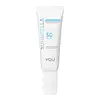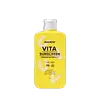What's inside
What's inside
 Key Ingredients
Key Ingredients

 Benefits
Benefits

 Concerns
Concerns

 Ingredients Side-by-side
Ingredients Side-by-side

Water
Skin ConditioningGlycerin
HumectantPropylene Glycol
HumectantPolymethyl Methacrylate
PPG-24-Glycereth-24
EmulsifyingButyl Methoxydibenzoylmethane
UV AbsorberEthylhexyl Triazone
UV AbsorberAcrylates/C10-30 Alkyl Acrylate Crosspolymer
Emulsion StabilisingAminomethyl Propanol
BufferingPhenoxyethanol
PreservativeHydroxyacetophenone
AntioxidantAllantoin
Skin ConditioningButylene Glycol
HumectantXanthan Gum
EmulsifyingDisodium EDTA
Pentylene Glycol
Skin ConditioningSodium Hyaluronate
HumectantGentiana Scabra Root Extract
Skin ConditioningPropanediol
SolventEctoin
Skin ConditioningArmillaria Mellea Extract
Skin ConditioningZea Mays Starch
AbsorbentHydrogenated Lecithin
EmulsifyingHydrolyzed Corn Starch
HumectantHydrolyzed Corn Starch Octenylsuccinate
AbsorbentLimonia Acidissima Extract
Skin ConditioningButyrospermum Parkii Butter
Skin ConditioningCocamidopropyl Dimethylamine
EmulsifyingBorago Officinalis Extract
EmollientPhenylethyl Resorcinol
AntioxidantMoringa Oleifera Seed Extract
Skin ConditioningCeramide NP
Skin ConditioningLactic Acid
Buffering1,2-Hexanediol
Skin ConditioningHydrated Silica
AbrasivePalmitoyl Tripeptide-5
Skin ConditioningCeramide As
Skin ConditioningCeramide Ng
Skin ConditioningEthylhexylglycerin
Skin ConditioningErgothioneine
AntioxidantCeramide EOP
Skin ConditioningCeramide AP
Skin ConditioningWater, Glycerin, Propylene Glycol, Polymethyl Methacrylate, PPG-24-Glycereth-24, Butyl Methoxydibenzoylmethane, Ethylhexyl Triazone, Acrylates/C10-30 Alkyl Acrylate Crosspolymer, Aminomethyl Propanol, Phenoxyethanol, Hydroxyacetophenone, Allantoin, Butylene Glycol, Xanthan Gum, Disodium EDTA, Pentylene Glycol, Sodium Hyaluronate, Gentiana Scabra Root Extract, Propanediol, Ectoin, Armillaria Mellea Extract, Zea Mays Starch, Hydrogenated Lecithin, Hydrolyzed Corn Starch, Hydrolyzed Corn Starch Octenylsuccinate, Limonia Acidissima Extract, Butyrospermum Parkii Butter, Cocamidopropyl Dimethylamine, Borago Officinalis Extract, Phenylethyl Resorcinol, Moringa Oleifera Seed Extract, Ceramide NP, Lactic Acid, 1,2-Hexanediol, Hydrated Silica, Palmitoyl Tripeptide-5, Ceramide As, Ceramide Ng, Ethylhexylglycerin, Ergothioneine, Ceramide EOP, Ceramide AP
Water
Skin ConditioningEthylhexyl Methoxycinnamate
UV AbsorberBenzophenone-3
UV AbsorberButyl Methoxydibenzoylmethane
UV AbsorberPhospholipids
Skin ConditioningButylene Glycol
HumectantPhenoxyethanol
PreservativeGlycerin
HumectantDimethicone
EmollientNiacinamide
SmoothingCetearyl Alcohol
EmollientCeteareth-20
CleansingGlyceryl Stearate
EmollientStearic Acid
CleansingOctocrylene
UV AbsorberCaprylyl Caprylate
Emollient
 Reviews
Reviews

Ingredients Explained
These ingredients are found in both products.
Ingredients higher up in an ingredient list are typically present in a larger amount.
Also known as Avobenzone, this ingredient is a chemical sunscreen filter that provides protection in the UV-A range.
Avobenzone is globally approved and is the most commonly used UV-A filter in the world.
Studies have found that avobenzone becomes ineffective when exposed to UV light (it is not photostable; meaning that it breaks down in sunlight). Because of this, formulations that include avobenzone will usually contain stabilizers such as octocrylene.
However, some modern formulations (looking at you, EU!) are able to stabilize avobenzone by coating the molecules.
Avobenzone does not protect against the UV-B range, so it's important to check that the sunscreen you're using contains other UV filters that do!
The highest concentration of avobenzone permitted is 3% in the US, and 5% in the EU.
Learn more about Butyl MethoxydibenzoylmethaneButylene Glycol (or BG) is used within cosmetic products for a few different reasons:
Overall, Butylene Glycol is a safe and well-rounded ingredient that works well with other ingredients.
Though this ingredient works well with most skin types, some people with sensitive skin may experience a reaction such as allergic rashes, closed comedones, or itchiness.
Learn more about Butylene GlycolGlycerin is already naturally found in your skin. It helps moisturize and protect your skin.
A study from 2016 found glycerin to be more effective as a humectant than AHAs and hyaluronic acid.
As a humectant, it helps the skin stay hydrated by pulling moisture to your skin. The low molecular weight of glycerin allows it to pull moisture into the deeper layers of your skin.
Hydrated skin improves your skin barrier; Your skin barrier helps protect against irritants and bacteria.
Glycerin has also been found to have antimicrobial and antiviral properties. Due to these properties, glycerin is often used in wound and burn treatments.
In cosmetics, glycerin is usually derived from plants such as soybean or palm. However, it can also be sourced from animals, such as tallow or animal fat.
This ingredient is organic, colorless, odorless, and non-toxic.
Glycerin is the name for this ingredient in American English. British English uses Glycerol/Glycerine.
Learn more about GlycerinPhenoxyethanol is a preservative that has germicide, antimicrobial, and aromatic properties. Studies show that phenoxyethanol can prevent microbial growth. By itself, it has a scent that is similar to that of a rose.
It's often used in formulations along with Caprylyl Glycol to preserve the shelf life of products.
Water. It's the most common cosmetic ingredient of all. You'll usually see it at the top of ingredient lists, meaning that it makes up the largest part of the product.
So why is it so popular? Water most often acts as a solvent - this means that it helps dissolve other ingredients into the formulation.
You'll also recognize water as that liquid we all need to stay alive. If you see this, drink a glass of water. Stay hydrated!
Learn more about Water